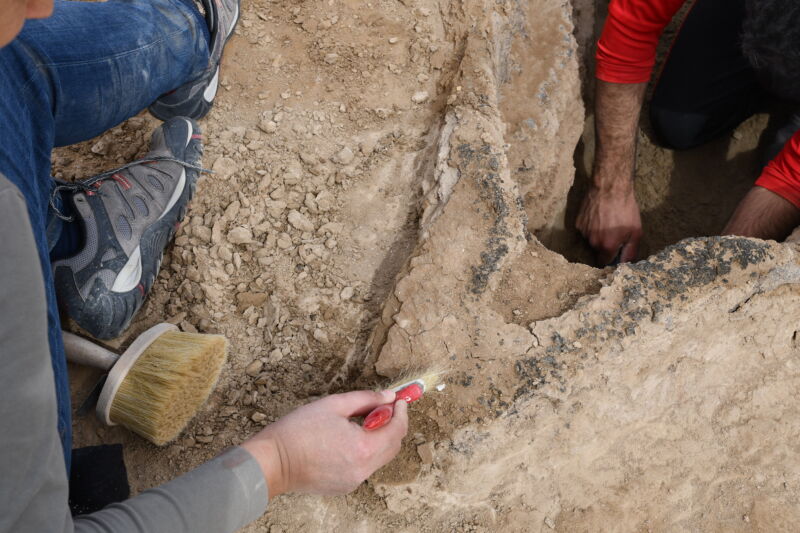All that’s left today of an ancient boat discovered in 2018 in what was formerly Uruk is the bitumen, black tar that once coated its framework of reeds, palm leaves, or wood. That fragile organic material is long gone, leaving behind only ghostly imprints in the bitumen. But there’s enough left for archaeologists to tell that in its heyday, the boat would have been a relatively slender craft—7 meters long and about 1.5 meters wide—well-suited to navigating the rivers and canals of ancient Sumer.
Archaeologists found the boat in an area that, 4,000 years ago, would have been the bustling hinterlands of the largest city in the world: Uruk. Founded in 5000 BCE from the merger of two smaller settlements on the bank of the Euphrates River, Uruk was one of the world’s first major cities and possibly even the birthplace of the world’s first writing (the oldest known writing samples in the world are tablets from Uruk). The Sumerian King List claims the legendary hero-king, Gilgamesh, ruled from his seat at Uruk in the 2600s BCE, which is not long before the recently excavated boat was built, sailed, and sank.
At its height around 3000 BCE, Uruk boasted 40,000 residents in the city, with a total population of about 80,000 or 90,000 people in the surrounding hinterlands. The area outside the city boasted smaller communities, farms, ancient manufacturing workshops, and networks of canals. Uruk was beginning its long, slow decline by 2000 BCE, around the time our boat was built.

Based on its resting place in layers of silty sediment, it seems that the boat sank in a river, which swiftly buried it and preserved it for the next 4,000 years. That ancient river has long since silted up, but a few years ago, it began to yield at least one long-held secret: erosion revealed the outline of the boat, which archaeologists documented with digital photos and measurements in 2018.
At the time, archaeologists from the Iraqi State Board of Antiquities and the German Archaeological Institute chose to leave the boat buried, where the ancient river’s silt could continue to protect it from decay and damage. But over the last few years, it became clear that the boat was no longer safe in its resting place. Erosion in the area had picked up the pace, and parts of the boat’s structure were sticking out above the surface.
“Traffic passing close to the site of the discovery was an acute threat to the preservation of the boat,” explained the German Archaeological Institute in a press release.
That led to a rescue mission in which archaeologists had to balance urgency with delicacy as they carefully excavated the boat from its once-watery, now-silty grave. They encased the boat and a block of the surrounding sediment in a shell made of clay and gypsum plaster to make it easier to safely unearth and move it. Now, 4,000 years after setting out on its ill-fated final journey, the boat has a new homeport: the Iraq Museum in Baghdad, where archaeologists will study and conserve what’s left of the hull and eventually display it to the public.



3175x175(CURRENT).thumb.jpg.b05acc060982b36f5891ba728e6d953c.jpg)

Recommended Comments
There are no comments to display.
Join the conversation
You can post now and register later. If you have an account, sign in now to post with your account.
Note: Your post will require moderator approval before it will be visible.